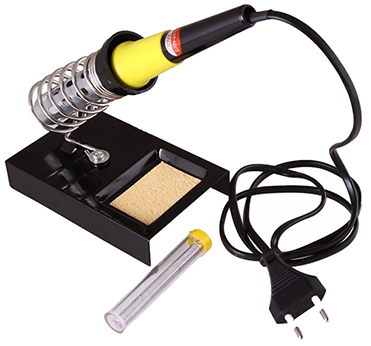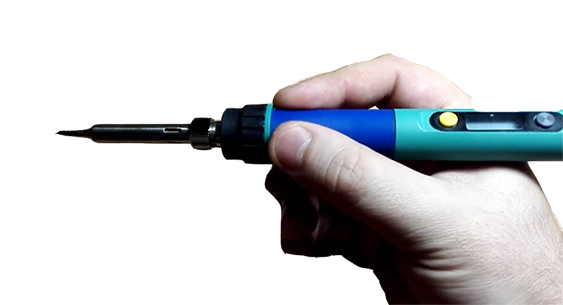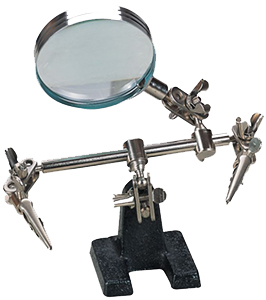Safety tips
Soldering

Soldering and tinning should be performed in specially prepared rooms. A ventilation system and a fume extractor are mandatory.
Before you start:
- Prepare your workplace. Nothing should interrupt the process. Your workbench should be well lit.
- Check the integrity of wiring and plugs of all electrical appliances.
- Place your soldering iron near the fume extractor. Use a soldering iron stand when the soldering iron is not in use.
- Wear safety goggles and gloves.
During soldering:
Use the soldering iron grip to hold the soldering iron. The tip is very hot!

The soldering iron tip can easily damage insulation which may lead to short circuits.
Use pliers, tweezers and other tools to safely handle wires and boards during soldering.
Do not pull wires too hard during desoldering operations to avoid burns by molten solder.
Use a special holder (a "helping hand") for soldering small components.

Don't hold the soldering iron by its wire or tip. Unplug the iron during breaks and after work.
WARNING
Unplug the soldering iron in case of malfunctions and/or fire.
Rosin and solder emit a considerable amount of harmful substances when heated. Vent the room after each soldering session. Take breaks every 30 minutes for full room ventilation; don't forget to unplug the soldering iron during these breaks.
Flights
Safety during pre-flight preparations
- Make sure that the Li-ion batteries are charged.
- Make sure the batteries in the control equipment are charged.
- Attach the propellers just before flying.
Check the following:
- Tightness of propeller nuts.
- Attachment and integrity of propellers guards.
- Reliability of wires attachment, absence of loose wires.
Safety before flight
- Place the spectators behind the pilot, or behind the line passing through both shoulders of the pilot behind the pilot.
- Do not allow spectators into the hemisphere in front of the pilot.
- Know and remember the flight duration that the copter and its battery are designed for.
- BEFORE connecting the Li-ion battery enable control equipment (the remote), and set the left stick (throttle) to the zero position.
- Connect the Li-ion battery immediately before takeoff, disconnect it immediately after landing.
- Stay at least 3 m away from the copter.
- Take off from a level flat site at the distance of at least 3 meters away from obstacles.
Flight safety
- Follow all instructions of the teacher or the flight instructor.
- Specify the flying area in advance. Only fly in the specified area, and avoid flying outside it. Not to fly over behind your back.
- When learning to fly, fly below the level of your height.
- Fly in proximity to yourself at a distance at which you can see the copter orientation in space. Do no fly far away from yourself. If you doubt copter orientation, immediately land on the spot. Do not try to take off. Approach the copter and take off.
- During the flight, move the control sticks carefully and smoothly. Avoid abrupt movements. If you have to change the flight direction, move the sticks vigorously, but not abruptly.
- Fly carefully, and perform only those flight elements that you are sure you can perform. Never perform the flight maneuvers that you doubt you can perform, and the maneuvers involving risks.
- Observe the speed limit. The copter speed should be maintained within the speed of a walking man.
- Return the copter to the landing location by the estimated time, prevent complete discharge of the battery during the flight.
- Land only on a flat open area away from obstacles
Emergency landing
In case of hitting the ground or a heavy landing, do the following:
- Stop the flight. Land the copter on the ground. Set the left stick (throttle) to the minimum
- Disarm (Move the left stick left-down for 3 seconds)
- Disconnect the Li-ion battery on the copter.
- Turn off the remote.
- Inspect the copter, and repair if necessary.
Scheduled landing
After a scheduled landing, do the following:
- Disarm (Move the left stick left-down for 3 seconds)
- Disconnect the Li-ion battery on the copter.
- Turn off the remote.
